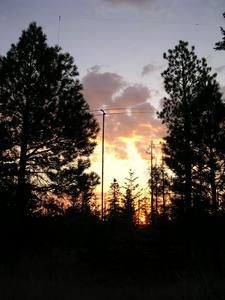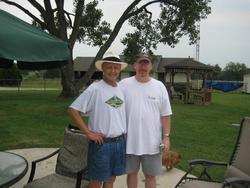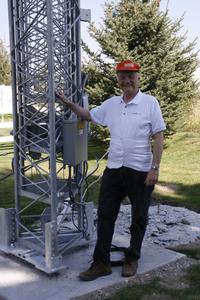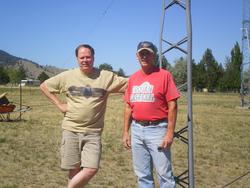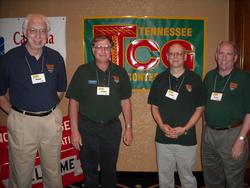 September 30, 2009 Editor: Ward Silver, NØAX | ||||||
IN THIS ISSUE
NEW HF OPERATORS - THINGS TO DO October is the busiest contest month, so there is no shortage of exciting action on the HF bands - the activity is thick and fall propagation has kicked in. Two of the biggest QSO parties (CA and PA) go back to back over the next week and the Oceania DX Contest gives you two weekends to try for some of that exotic Pacific DX. You can rake leaves through the week! BULLETINS Time is short! The deadline for submitting applications to be a Team Leader at WRTC-2010 is October 1st! Referees can submit their applications between Oct 1 and Nov 1. Please see the WRTC-2010 Web site for information about how to submit your application. (Thanks, Harry RA3AUU) BUSTED QSOS A golden issue last time! CONTEST SUMMARY Complete information for all contests follows the Conversation section Oct 3-4
Oct 10-11
NEWS, PRESS RELEASES, AND GENERAL INTEREST A CQP Sweep (a SCQWEEP?) is now officially possible - from the online map, all of the California QSO Party multipliers (i.e. California counties) will be at least temporarily active. Lots of teams have signed up, packed up, and will be traveling the trails of CalTrans this weekend and looking for you! (Thanks, Garry NI6T)
In celebration of the Worked All Zone award program's 75th anniversary, CQ magazine is announcing a limited-term "Diamond Jubilee WAZ" award. A special certificate will be issued to amateurs who make contacts in all 40 CQ Zones of the World between November 1, 2009 and December 31, 2010. Certificates will be numbered but there will be no endorsements. Confirmations will not be required. Full details are available on the CQ Web site or in the October issue of CQ Change is in the wind at Alpha Radio Products as a newly-formed RF Concepts, LLC, has acquired Alpha and all its products as of September 2009. The entire product line will continue to be manufactured in Boulder, CO. Alpha will continue to be available at the same phone number. Extra efforts are being made to reduce the backlog of orders and maintain inventory for off-the-shelf shipping. This is very good news for Alpha customers - past, present, and future! It's interesting to note that 11 years ago, this headline was an item in the ARRL News: "Alpha/Power Buys RFconcepts". Obviously, not the same company, but somewhat recursive, nonetheless. (Thanks, Rich KL7RA and Bob N6TV)
ARRL Sweepstakes is coming and what better fall activity for a collegiate radio club? To encourage more entries from our secondary institutions, ARRL Contest Branch Manager, Sean KX9X has written a short article on collegearc.com to help clubs get on the air for SS. If you're an alumnus of such a club, you might point them in the direction of this article to help answer questions and fan the competitive flame. The FCC rule-making process is certainly a long and winding road, somewhat inscrutable to the layperson, and frustratingly glacial to the petitioner. The article "Radio's Regulatory Roadblocks" by Mitchell Lazarus in the September 2009 issue of IEEE Spectrum sheds some light on the FCC process and why it takes so long for the wheels to turn. While you're browsing the Spectrum pages, Robert Lucky's column, "The First Book of Electronics" will surely strike a chord as it recalls the Alfred P Morgan series of introductory books on electricity for young readers. In the previous issue, this weekend's California QSO Party was reported to be the oldest of the state QSO parties. Not true! The state contest with the longest history of every-year activity appears to be the CQP's cross-continent rival Pennsylvania QSO Party, with its 52nd running in 2009 a Jacob Marley-esque seven years older. (Thanks, Jim K8MR and Ron N3WN) The very first state QSO party of any kind, at least one that was reported in QST, was the West Virginia QSO Party with its third running in 1947. (Given the intervening war years, the dates of the first and second running are currently unknown). The Dakota Division's 1934 QSO party and the NNJ Section's 1935 QSO party are other early QST references. (Thanks, Alan N5NA) Now that we have all that established, let's go out and make some QSOs!
Once those QSOs have been logged, they're submitted to the contest sponsor mostly in electronic form these days. Surely, this is a recent phenomenon? Well, not exactly. Tod KØTO reports submitting a computer-printed log to the ARRL in 1958 and being told that "it had been done before." I can just see the IBM line printer erupting sheet after 17-inch-wide, fan-fold, green-striped sheet of tractor-fed log data! Any claims to the title of "first computer-printed log submission"? More history - this time on the Eimac company, originator of many vacuum tubes that writ large the story of ham radio, adding the bold, the italics, and the underline to the signals of top-scoring stations. (Thanks, Rich KL7RA) Kindle it's not, but if you want something a little more interesting than five-letter code groups for CW practice, try this high-speed Morse stream from literary works! (Thanks, George K5TR) Subscribers to the free Ham-Mag electronic magazine were treated to Dick WØRAA's article "Getting Started in Casual Contesting" in the August 2009 (number 7) issue. This is nicely written for the target audience, encouraging hams with a small HF station to try radiosport. The magazine also includes an article on a multiple microphone and sound-card switch and while you're there, see if you can find the photo of an antenna that will surely rake in a lot contacts. Jim AD4EB gave a well-received presentation at the SEDCO convention on using the MMTTY RTTY engine with the N1MM contest logging software. While the audio and video portion of the presentation will have to be imagined, the text of the presentation has been converted to PDF and posted online by K4RO along with Kirk's presentation, "Contesting 101." The latest ham-related hoax making the e-rounds purports to be from the ELF vilifying ham radio as a health threat. It is perhaps a sign of the over-heated times that we squeal, "Really?" and reach for the Forward button, instead of an incredulous, "Oh, come on..." and hitting Delete, but it is worth a reminder to check these things out before forwarding them and lending unnecessary credence to foolish behavior. Web Site of the Week - The VHF Distance Scoring Working Group is a grass-roots, independent activity outside of the usual contest sponsor committee structure and has been considering many distance scoring options over the last several months. It was thought that ideas could be developed by the VHF community itself for further consideration of all potential sponsors. The full report of the working group is now available. A VHF+ contest using this type of scoring would certainly encourage the develop of some new contesting strategies! WORD TO THE WISE Cloudburner - You've heard the term "NVIS" probably, referring to the use of high-angle signals to provide regional coverage on the lower HF bands. Before it got a snazzy FLA (four-letter acronym), an NVIS antenna was called a "cloudburner" and is still part of every domestic contester's aluminum arsenal. High-angle signals from low dipoles on 14 MHz and lower frequencies allow you to maximize short-skip QSOs. When sunspots are low and 40 and 80 meters hot, putting up a cloudburner to complement your low-angle DXing antenna is a good strategy. SIGHTS AND SOUNDS You know how this is going to turn out, but you can't not watch a video titled "HV Capacitor Bank versus Watermelon"! Just remember it the next time you're working on the amplifier power supply and be safe. (Thanks, Lynn N7CFO) The VY2ZM station continues to chew its way through the record books and this video gives you an idea of why. Taken from a 170-foot perch above the Atlantic, is that Rockall I see on the horizon? (Thanks, Ray W2RE) Dennis K1YPP was the subject of an interview with "Doing Stuff Outdoors" about his ham radio hiking experiences on the Appalachian Trail. The interview is available online and mentions ham radio in a new context. Harry KCØNTJ tipped me off to an enjoyable Web site with a "Tower Site of the Week" feature. Well, we can dream, can't we? What happens when a wind turbine loses its brakes? You can find out about halfway through this video from Germany. (Thanks, Rich KL7RA) Care to take a Field Day adventure back to the days when tents were tents and radios had handles? (Thanks, Andy N2NT)
Here's a Web site, complete with video, from a bunch of Canadian hams who launched a high-definition video camera, tethered to a hydrogen-filled balloon that rose to 107,000 feet! They used amateur radio to track the balloon. (Thanks, John KE7HCA) In the nostalgia department, Bob N6TV sends word that, "The West Virginia Museum of Radio and Technology seems to have very nice collection." Highlights include lots of ham gear, interesting broadcasting remnants, and a spark-gap transmitter video. This is good for browsing while you're chasing the DXpeditions. This is Dave KM3T's favorite t-shirt that he doesn't yet own - maybe yours, too! RESULTS AND RECORDS The first chapter of the CQ WPX contest survey results have been posted for your inspection. (Thanks, CQ WPX Director, Randy K5ZD) CQ WW 160 Meter Contest Plaque Manager, Doug K1DG announces that all previously unsponsored plaques now have a sponsor. He wishes to thank all of the donors that stepped up to make sure every category was recognized. Lew W7EW writes that, "The Boring Amateur Radio Club is pleased to release the results of the 13th running of the Stew Perry TopBand DX Challenge." Plaques will be mailed shortly after Nov 1. The official 14th Edition of The Stew Perry TopBand DX Challenge will be December 26-27, 2009. Judges from the Cheese Hollow ARS met Monday, September 21, 2009 and determined the official results of the 2009 Maryland-DC QSO Party, the final year of its sponsorship by the Antietam Radio Association. Look for a new sponsor next year! (Thanks, Page WA3EOP) OPERATING TIP Turn it down! By turning down your receiver's gain, you'll accomplish three things. First, your ears will love you for it. Excessive audio levels leads to hearing loss, eventually. (What?) Second, your receiver will be far less susceptible to overload that creates distortion and spurious products all over the band. Third, by reducing gain, band noise will be amplified less, making the band sound quieter. All three of these things reduce operator fatigue and improve copy of signals on a crowded band. The result? Bigger scores! TECHNICAL TOPICS AND INFORMATION The Contesting Compendium now includes K7NV's Guyed Tower Study. It's good reading for someone who is planning to build or improve a tower. While you're there, you can also take a look at the just-published article by K3NA and W2VJN on the VP6DX receiving antennas. (Thanks, Pete N4ZR) Petr OK1RP has done a survey of fiberglass masts used as antenna supports and posted ten online articles about them. In his experience, the really tall masts are too thin to support any meaningful weight at their full heights. If you want a 12-meter support, for example, you will need an 18-meter mast because the upper sections aren't strong enough. He recommends removing the upper sections and using them to hold up tomato vines in the garden! Petr also says to paint the mast with several layers of UV-protection lacquer or varnish to avoid damage from sunlight. Jim K5LAD has posted the possibly helpful article "Repairing a Tail-Twister Rotator" to help others with balky rotators. In his case, the stainless steel ring gear was damaged, so the repair saga gets into the basics of rotator operation and design.
Here's a neat idea for providing power to remote preamps without cables. Herb KV4FZ suggests "...self-contained solar-powered yard lights that switch on at dusk. Remove the lamp and use them for power sources at each pre-amp location....the self-contained rechargeable battery should handle [the small preamp supply current load] all night. Such a power source would also mitigate any problems associated with ground loops, circuitry wire, power inserter, etc." Now, how would you turn them off? Speaking of solar-powered, the solar wind seems to be a bit more important in ionospheric geo-physics than was previously thought according to this UCLA article. On a similar subject, NM7M and K9LA have proposed an interesting theory about 160 meter duct propagation in the 2008 issue of CQ magazine. And how much does sunspot activity affect the weather? There's still a lot of interesting science "up there" for hams to explore! (Thanks, Glenn K6NA and Mark K6UFO) How do you test a vacuum capacitor, anyway? Thanks to Peter DF3KV (an appropriate call sign), we can read Comet Service Bulletin SB-28 and find out! You can save yourself th effort of having to travel to a recycling center with recyclable batteries by using the Call2Recycle Web site. By signing in you can receive postage-prepaid containers for the batteries. (Thanks, Tom N4NW) Here's a tip on splicing three-strand rope together to run a new rope through an existing pulley: "I use a small length of concrete rebar tie wire. Push it through the rope about an inch from the end and fold it back and tape the end with electrical tape. Push the other end through the new rope and do the same. The tie wire is strong, but flexible and will bend going thru the pulley. This method does not leave a big joint to go thru the pulley. I have used the same method to pull coax or control cables in my underground PVC pipes going to the tower." (Thanks, Jim W5IFP) Frank W3LPL also tosses out a line on rope, "To avoid premature rope failure, a pulley's sheave diameter should be at least eight times the diameter of the rope. The width of the U-shaped groove should be approximately 10 percent greater than rope diameter. The depth of the U-shaped groove should be approximately 1/2 the rope diameter. If you change rope diameter, the pulley should always be replaced with a new pulley with the correct groove width and depth. You can extend rope life by rigging the rope so that it wraps around as little of the sheave circumference as possible. A rope that wraps around half of the sheave circumference will have a much longer life than a rope that wraps almost entirely around the sheave." Big hand-held drills can be dangerous if the bit catches or binds causing the drill (and its holder) to rotate instead. Here are some good safety pointers from Roger K8RI: "Always hold [the drill] in such a manner that the trigger can be released if the bit catches. Hold it so the trigger will not be forced against *anything* if the drill motor starts to turn. Be well aware of where the cord is located and keep it well away from all parts of your body." Fingers have been removed and innumerable bruises caused by a powerful motor that can't be turned off. Technical Web Site of the Week - Last Thursday's Webinar on HFTA by N6BV is now on-line? It was a live demo, step by step, on how you can download terrain for your station location and analyze the takeoff angle response of your HF antennas. W6YI's station was used as an example. You can view this collaboration by the PVRC and NCCC online, either playing it while it downloads or saving the file and playing it back later. It's a 137 Mbyte WMV file, so obtaining it might take some time! (Thanks, Dean N6DE) CONVERSATION The Pig In the Snake The title refers to the well-known demographic distribution of ham radio and to contesters, specifically. Every year, the pig - the graph representing our ages and population -- gets a little smaller and moves a little farther to the right - older. We'd all like to see that trend reversed, of course, and there is a sense on this side of the Atlantic Ocean, that the European contest crowd is a little less "digested", shall we say? So John K1AR took an informal survey and here are his results from a recent CQ-Contest reflector post: Total Responses: 160 Responses by Geography:
Total Data:
US/VE-only Data:
DX (all non-US/VE) Data:
Europe-only Data:
Although John's results are from a small sample, the trend is clear that European (and non-US/VE overall) contesters are younger than their US/VE competitors. The senior member in this group is Jim, W3CP at 92 years young and Cal, KØDXC, takes the youthful title at 14. Along with the numeric data, John made some other interesting observations: (1) Lots of non-US contesters started in club stations, even before they had their own personal call signs. (2) Field Day and the ARRL Novice Roundup were the two operating events that spawned interest in contesting for many survey participants. (3) There are quite a few contesters in the group who got off to a late start, often being a ham for decades before starting to operate contests. There is a bit of a common element in those three observations - mentoring and entry-level events. These make it easier for potential contesters to learn the ropes and get some experience. I've sung the praises of Field Day many times, as have many of my readers, as a great way to demonstrate competitive operating and introduce the interested. We've got a School Club Roundup coming up shortly - maybe that would be a good way to help out from the other end of the QSO, so to speak. If you look over the list of the fall's coming contests, there are lots of opportunities to get new contesters involved - the ARRL 10 Meter contest is one of my favorites, even at the low end of the sunspot cycle. Simple antennas and low power can produce surprisingly good results with a little coaching. That ten-year gap in average ages across the pond is encouraging in that it shows us there is interest and opportunity...if we try. It takes a bit of a personal touch, but I'm sure there are potential radiosport recruits that would respond to your offer of some coaching or sponsorship of a multi-operator effort conducted at an appropriate pace. Or are you comfortable with being digested? CONTESTS 30 September to 13 October An expanded, downloadable version of QST's Contest Corral in PDF format is available. Check the sponsor's Web site for information on operating time restrictions and other instructions. HF CONTESTS PSK Rumble - The Fall Classic--Digital, from Oct 3, 0000Z to Oct 3, 2400Z. Bands (MHz): 1.8-28, 50. Exchange: Name and S/P/C. Logs due: Oct 31. Rules Digital SSTV Contest --Digital, from Oct 3, 0000Z to Oct 13, 2400Z. Bands (MHz): 3.5-28, 50. Exchange: Complete image exchange. Logs due: Nov 30. Oceania DX Phone Contest--Phone, from Oct 3, 0800Z to Oct 4, 0800Z. Bands (MHz): 1.8-28. Exchange: RS and serial. Logs due: Nov 9. Rules EU Autumn Sprint--Phone, from Oct 3, 1600Z to Oct 3, 1959Z. Bands (MHz): 3.5-14. Exchange: Both call signs, serial, name. Logs due: 15 days. Rules California QSO Party--Phone,CW, from Oct 3, 1600Z to Oct 4, 2159Z. Bands (MHz): 1.8-28, 50,144. Exchange: Serial and state/prov/"DX" or CA county. Logs due: Nov 15. Rules RSGB 21/28 MHz Contest--Phone,CW, from Oct 4, 0700Z to Oct 4, 1900Z. Bands (MHz): 21,28. Exchange: Serial and UK district. Logs due: Oct 19. Rules YLRL Anniversary Party--CW, from Oct 9, 1400Z to Oct 11, 0200Z. Bands (MHz): 1.8-28. Exchange: Serial, RST, and section/province/country. Logs due: 30 days. Rules Makrothen Contest--Digital, from Oct 10, 0000Z to Oct 11, 1600Z. Bands (MHz): 3.5-28. Exchange: Grid square. Logs due: 15 Nov. Rules 10-10 Sprint--Phone,CW,Digital, from Oct 10, 0001Z to Oct 10, 2359Z. Bands (MHz): 28. Exchange: Call, name, 10-10 number, S/P/C. Logs due: 15 days. Rules Oceania DX CW Contest--CW, from Oct 10, 0800Z to Oct 11, 0800Z. Bands (MHz): 1.8-28. Exchange: RST and serial. Logs due: Nov 9. Rules Worked All Britain HF Contest--Phone, from Oct 10, 1200Z to Oct 11, 1200Z. Bands (MHz): 14-28. Exchange: RS, serial, DXCC entity or WAB area. Logs due: Nov 1. Rules EU Autumn Sprint--CW, from Oct 10, 1600Z to Oct 10, 2000Z. Bands (MHz): 3.5-14. Exchange: Both call signs, serial, name. Logs due: 15 days. Rules Pennsylvania QSO Party--Phone,CW,Digital, from Oct 10, 1600Z to Oct 10, 0500Z and 12 Oct, 1300Z to 12 Oct, 2200Z. Bands (MHz): 1.8-28, 50,144, Frequencies: CW--40 kHz above band edge and 1.810; SSB--1.850, 3.825, 7.200, 14.280, 21.380, 28.480. Exchange: Serial and ARRL/RAC section. Logs due: Nov 15. Rules Arizona QSO Party--Phone,CW,Digital, from Oct 10, 1600Z to Oct 11, 0400Z and Oct 11, 1400Z to Oct 11, 2359Z. Bands (MHz): 1.8-28, 50,144, Frequencies: CW--1.812 and 48 kHz above band edge; Phone: 1.848, 3.848, 7.248, 14.248, 21.348, 28.448, 146.48. Exchange: RS(T) and AZ county or S/P/C. Logs due: Oct 31. Rules FISTS Fall Sprint--CW, from Oct 10, 1700Z to Oct 10, 2100Z. Bands (MHz): 3.5-28. Exchange: RST, S/P/C, name, FISTS number or pwr. Logs due: 30 days. Rules North American RTTY Sprint--Digital, from Oct 11, 0000Z to Oct 11, 0400Z. Bands (MHz): 3.5-14. Exchange: Both call signs, serial, QTH, name. Logs due: 7 days. Rules SKCC Monthly Weekend Sprint--CW, from Oct 11, 0000Z to Oct 11, 2359Z. Bands (MHz): 3.5-28. Exchange: RST, S/P/C, SKCC nr or power. Rules VHF+ CONTESTS PSK Rumble - The Fall Classic--Digital, from Oct 3, 0000Z to Oct 3, 2400Z. Bands (MHz): 1.8-28, 50. Exchange: Name and S/P/C. Logs due: Oct 31. Rules Fall VHF Sprints--Phone,CW,Digital, from Oct 7, 7 PM to Oct 7, 11 PM. Bands (MHz): 432. Exchange: Grid square. Logs due: 4 weeks. Rules ARRL EME Contest--Phone,CW,Digital, from Oct 10, 0000Z to Oct 11, 2359Z. Bands (MHz): 50-1296. Exchange: Both call signs, signal report. Logs due: Jan 5. Rules Arizona QSO Party--Phone,CW,Digital, from Oct 10, 1600Z to Oct 11, 0400Z and Oct 11, 1400Z to Oct 11, 2359Z. Bands (MHz): 1.8-28, 50,144, Frequencies: CW--1.812 and 48 kHz above band edge; Phone: 1.848, 3.848, 7.248, 14.248, 21.348, 28.448, 146.48. Exchange: RS(T) and AZ county or S/P/C. Logs due: Oct 31. Rules LOG DUE DATES 30 September to 13 October September 30 - AGCW Straight Key Party, email logs to: htp@agcw.de, paper logs and diskettes to: Friedrich W. Fabri, DF1OY, Moselstrasse 17b, D-63322 Roedermark-Urberach, Germany. Rules September 30 - ALARA Contest, email logs to: alaracontest@wia.org.au, paper logs and diskettes to: Mrs. Lesley Smit, VK5HLS, PO Box 271, Ashton 5137 SA, Australia. Rules September 30 - MMMonVHF/DUBUS 144 MHz Meteorscatter Sprint Contest, email logs to: mssprint@mmmonvhf.de, paper logs and diskettes to: (none). Rules September 30 - RSGB 80m Club Sprint, CW, email logs to: cwsprint.logs@rsgbhfcc.org, upload log at: http://www.vhfcc.org/cgi-bin/hfcover.pl, paper logs and diskettes to: (none). Rules September 30 - IARU Region 1 Field Day, SSB, email logs to: (see your national society rules), paper logs and diskettes to: Your national society. Rules at your national society Web site. October 1 - Kansas QSO Party, email logs to: logs@KsQSOParty.org, upload log at: http://logs.KsQSOParty.org, paper logs and diskettes to: Kansas QSO Party, c/o Randy Wing, N0LD, 13038 SW 186th St., Rose Hill, KS 67133-8559, USA. Rules October 1 - Feld Hell Sprint, email logs to: (none), post log summary at: http://www.emailmeform.com/fid.php?formid=202397, paper logs and diskettes to: (none). Rules October 1 - Russian RTTY WW Contest, email logs to: contest@radio.ru, paper logs and diskettes to: Russian RTTY WW Contest, Radio Magazine, Seliverstov per. 10, Moscow 107045, Russia. Rules October 5 - SARL VHF/UHF Contest, email logs to: sarl.contest@peer.co.za, paper logs and diskettes to: The Contest Committee, PO Box 11198, Queenswood, 0121 Pretoria, South Africa. Rules October 6 - Colorado QSO Party, email logs to: coqplogs@ppraa.org, paper logs and diskettes to: Colorado QSO Party, PO Box 16521, Colorado Springs, CO 80935-6521, USA. Rules October 6 - DARC 10-Meter Digital Contest, email logs to: df5bx@darc.de, paper logs and diskettes to: Werner Ludwig, DF5BX, P.O. Box 1270, 49110 Georgsmarienhuette, Germany. Rules October 6 - International G3ZQS Memorial Straight Key Contest, email logs to: hallinl@lanecc.edu, paper logs and diskettes to: Lee Hallin N7NU, 3413 Walton Ln, Eugene OR 97408, USA. Rules October 7 - MI QRP Labor Day CW Sprint, email logs to: n8xx@arrl.org, paper logs and diskettes to: Hank Greeb, N8XX, 5727 11 Mile Rd NE, Rockford, MI 49341, USA. Rules October 9 - AGB NEMIGA Contest, email logs to: eu1eu@mail.ru, paper logs and diskettes to: Igor "Harry" Getmann, EU1EU, P.O.Box 143, Minsk 220005, BELARUS. Rules October 10 - SARTG WW RTTY Contest, email logs to: contest@sartg.com, paper logs and diskettes to: SARTG Contest Manager, Ewe Hakansson, SM7BHM, Pilspetsvagen 4, SE-29166 Kristianstad, Sweden. Rules October 11 - PODXS 070 Club Jay Hudak Memorial 80m Sprint, email logs to: jbudzowski@verizon.net, paper logs and diskettes to: Jay Budzowski, N3DQU, 109 S. Northview Ave., New Castle, PA 16102, USA. Rules October 12 - AGCW VHF/UHF Contest, email logs to: vhf-uhf@agcw.de, paper logs and diskettes to: Manfred Busch, DK7ZH, Ebachstr. 13, D-35716 Dietzhoelztal-Mandeln, Germany. Rules October 12 - SOC Marathon Sprint, email logs to: n4bp@bellsouth.net, paper logs and diskettes to: Bob Patten, N4BP, 2841 N.W. 112 Terrace, Plantation, FL 33323, USA. Rules October 12 - Swiss HTC QRP Sprint, email logs to: HB9BQB@uska.ch, paper logs and diskettes to: Guido Giannini, HB9BQB, Kleinzelglistrasse 6, CH-8952 Schlieren, Switzerland. Rules October 12 - Ohio State Parks on the Air, email logs to: chuckw8pt@gmail.com, paper logs and diskettes to: Ohio State Parks on the Air, c/o Chuck Patellis, W8PT, P.O. Box 707, Parkman, OH 44080, USA. Rules ACKNOWLEDGEMENTS ARRL Contest Update wishes to acknowledge information from WA7BNM's Contest Calendar and SM3CER's Contest Calendar. | ||||||
